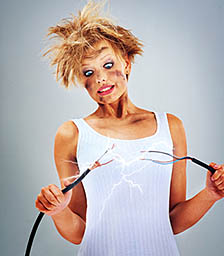 About 4 years ago I wrote a post where I summarized what I believed was the holy grail of what sold well and what kind of content was in high demand for online stock agencies. I was mainly focused on stock photography (microstock), and today’s topic will be the same, albeit in an updated version: I know many of you have requested this for quite some time, so here we go.
About 4 years ago I wrote a post where I summarized what I believed was the holy grail of what sold well and what kind of content was in high demand for online stock agencies. I was mainly focused on stock photography (microstock), and today’s topic will be the same, albeit in an updated version: I know many of you have requested this for quite some time, so here we go.
What has happened in stock photography during the last 4 years? We have done some research in regards to what sells in 2012, and you should be aware of some big changes in the industry.
 Decreasing sales and increasing competition
Decreasing sales and increasing competition
As all active microstock photographers must have noticed, we have seen a constant decrease in sales in terms of our return per image over the last few years. It’s becoming increasingly difficult to shoot great images and profit from it in the same way as it was 5 or 6 years ago. Many critics have claimed that the microstock industry is almost entirely devoid of artistic sensitivity, and is instead only concerned with making an easy profit. But surprisingly, this harsh criticism seems to have had a positive effect on the industry as a whole, because although the return per image has decreased a lot, I have also witnessed an interesting tendency: To make sales now, it’s about getting back to the roots of photography. More artistic, less processed images, and a more naturalistic style, which I, personally, fully endorse. It’s great to see some more artistic and natural images making their way up on the “most downloaded” lists as opposed to the more conventional microstock images that are always overly retouched, overly bright and overly clean.
In terms of overall industry image and concept popularity, we are seeing some stars falling while others are on the rise. And we are talking about some really huge stars here. Concepts and image types that used to sell better than anything are becoming less and less interesting for buyers because the market is now saturated with them. Below I have tracked some of the major shifts within 4 well-known microstock concepts: Lifestyle, business, health and wellness, and spa.
1. Lifestyle
Lifestyle images covers the subject matter wherein people are photographed in various aspects and situations from their daily lives, e.g. engaged with their hobbies, working situations, preparing dinner, spending time with their family, etc. All the things that make up what people do in their lives and their choices in how they do them. It is usually depicted in a positive light, and “lifestyle photography” is often synonymous with images of memorable moments of family and personal life: birthdays, a day on the beach, looking at photo albums together, playing a game, etc. However, it’s easy to see that the concept of “lifestyle” has become exceptionally well represented throughout all online stock libraries. The market is now flooded with lifestyle images because it’s an easy concept to shoot. It is easy to go about and easy to compile a good shoot list of images you want to shoot while on set, and you don’t need too many special props for the images to turn out great. We find that “lifestyle” has become such an overly crowded area that only a few images within this category will sell any more. Many images are lost in the vast sea of millions of similar-looking lifestyle images, and in order to excel, your images will really need to have something very, very unique about it to make it stand out from what else is out there.
 Now is the time for good ideas instead of mass production and as a new microstock photographer, I would stay away from lifestyle. The chance of getting just a tiny part of the action in this area is close to zero. If you look at PeopleImages.com, you’ll see that new lifestyle images are continuously being added to our collection, but you will also see that the shoot dates are older. Almost all of these files are left-over files from the previous years or have been taken from trainee shooting. These are files that are still in the post-production state, and currently we’re slowly but steadily working through the heap of undeveloped, unretouched and unkeyworded batches one file at a time. If you look at more recent shoots (check the shoot dates), you’ll no longer find any of the traditional lifestyle concepts depicted. This is an important shift for us, as we are definitely one of the companies considered to be a major lifestyle images provider.
Now is the time for good ideas instead of mass production and as a new microstock photographer, I would stay away from lifestyle. The chance of getting just a tiny part of the action in this area is close to zero. If you look at PeopleImages.com, you’ll see that new lifestyle images are continuously being added to our collection, but you will also see that the shoot dates are older. Almost all of these files are left-over files from the previous years or have been taken from trainee shooting. These are files that are still in the post-production state, and currently we’re slowly but steadily working through the heap of undeveloped, unretouched and unkeyworded batches one file at a time. If you look at more recent shoots (check the shoot dates), you’ll no longer find any of the traditional lifestyle concepts depicted. This is an important shift for us, as we are definitely one of the companies considered to be a major lifestyle images provider.
 Last time I was shooting one of my favorite models, Emma, we opted against redoing the classic lifestyle concepts that we’ve shot with her so many times before, and instead we shot some very unconventional images of her.
Last time I was shooting one of my favorite models, Emma, we opted against redoing the classic lifestyle concepts that we’ve shot with her so many times before, and instead we shot some very unconventional images of her.
Don’t be an Instapundit!
Right now, we’re seeing a very popular market for instagram-looking images. This kind of lifestyle photography has been commercialised to such an extent that now everyone can take fashionista images with their smart phones using one of the 1,00+ apps readily available to them. However, such trends in photography are often short-lived. Think of when we for the first time could take “sepia” tone images on our digital cameras. This effect became available on cameras about 10 years ago. People loved taking “sepia photos” that had that old ‘authentic’ look. After the “sepia” era, we saw the ‘enhanced details-dodge&burn” era, that about a year ago was replaced by the new hype: Crossbalance! It was rapidly adopted by the fashion industry who did more cross-balancing than ever before, and now we see it at the extreme end with apps such as Instagram that can produce highly distorted and highly noisy shots. However, whenever anything goes to such extreme, there’s usually a counter reaction just around the corner. While highly cross-processed effects are currently very popular, I can now share with you all that we have been planning to go directly against this trend and look beyond it. We are beginning to back away from this style, which does look very trendy but also highly processed. We strive for a more naturalistic and less processed style in our more recent creative briefs. You can create more naturalistic looking effects with very basic methods:
- Lens flair
- Silhouettes
- Wind in the hair
- Blitz
- Funky color balance.
- Tilt and shift lenses to distort the focal plan.
- Lens babies
- Foreground filters
 Unfortunately, we believe that the images of the “instagram wave” will appear very out-dated in 2-3 years from now, so we’re staying away from this. Imagine your first reaction when you found out about the sepia effect: it looked great! But take a look at your sepia images now… Do they still look amazing? Or just amateurish and out-dated? My guess is that you will look at those overly processed lifestyle images in exactly the same way in a few years from now. In the arsenal of camera techniques there are plenty of tools which can help you to create very artistic and beautiful long-lived lifestyle images. My advice is to be careful about the over processing, and go back the basics.
Unfortunately, we believe that the images of the “instagram wave” will appear very out-dated in 2-3 years from now, so we’re staying away from this. Imagine your first reaction when you found out about the sepia effect: it looked great! But take a look at your sepia images now… Do they still look amazing? Or just amateurish and out-dated? My guess is that you will look at those overly processed lifestyle images in exactly the same way in a few years from now. In the arsenal of camera techniques there are plenty of tools which can help you to create very artistic and beautiful long-lived lifestyle images. My advice is to be careful about the over processing, and go back the basics.
I hope I’m not giving out too much of my soul here, because I’m basically revealing to you our production rationale for the next two or three years, but I do feel this way. I believe there will still be a good market for the instagram-looking images for the next year or two, but after then they’ll be a dead duck. You’ll have to be careful if you want to stay on top of your game, and you should always look ahead. At least for now keep a backup of your original non-instagram image files.
2. Business Images
The second major shift has been within an old-time super star of stock: Business images. It is still considered by Getty and many others as one of the best-selling concepts for any stock agency out there. We have seen that the kind of content I have been known for shooting – the classic business shots – has been copied, plagiarized and duplicated to an extreme that is some so overt that it is even public, as can be seen in this forum thread.
So extreme, in fact, that now even we find it difficult to compete in this sector despite this being an area I have always been known for shooting very well. Because of the formal format in which business images are used, they are often represented by a series of easy-to-go-to image types that can be done with relatively limited means and in an easily structured manner. Like we have seen with “lifestyle” concept, the market for business images is so over-saturated that it’s almost impossible to get a piece of the action.
We do still shoot business images, but now when we approach this concept we focus less on the classics. While the classic business concepts are dropping in sales, we see an increase in sales depicting business in crisis. Personally I don’t think this rise has much to do with the global financial crisis as such, so much as that we, as human beings always have a lot of crisis- related concepts in mind. The financial crisis is now slackening in many parts of the globe, but we still use its rhetoric and metaphors in the things we publish. Because of this, there is still a great demand for images related to the concepts of the less savory side of business life. People are less occupied with the fun and happiness of business, and are more focused on serious issues such as long working hours, stressful working environments, the familiar “back pains from sitting in the office chairs for too long”, etc. which photographers have tried to avoid shooting for years.
 Last time I did a business shoot with one of my other favorite models, Rodrigo (who is also, by the way, the most ‘downloaded man’ in the world), I didn’t shoot any of the classic business concepts at all. Instead I only focused on strange and more conceptual ideas. More wild concepts. While the sales for these kinds of concepts are still relatively small, they are already greater than the sales of newly-produced images depicting classic business concepts that are so overdone right now.
Last time I did a business shoot with one of my other favorite models, Rodrigo (who is also, by the way, the most ‘downloaded man’ in the world), I didn’t shoot any of the classic business concepts at all. Instead I only focused on strange and more conceptual ideas. More wild concepts. While the sales for these kinds of concepts are still relatively small, they are already greater than the sales of newly-produced images depicting classic business concepts that are so overdone right now.
3. Medical/Health
Almost everything said about business can also be said about medical images. Swop the suit for some scrubs, give your models a stethoscope instead of a mobile phone or a clipboard, and that’s basically it. It’s so easy to create, and there are so many of these kinds of images that it’s almost impossible to get a cut of the field with any success.
Images of healthy foods have been a major part of the stock industry for a long time, but here we are seeing an interesting new tendency: buyers are moving away from the foods generally perceived as healthy to more specific food issues. Food images are not something we have done much of in the past, because it is so simple and not very specific, but with the food frenzy going on amongst people today, it becomes much more interesting for us to do. We recently did a shoot in which we focused mainly on low GI foods and not just on the fresh and healthy looking fruits and vegetables.
 The properties of the ingredients are becoming more important than their physical appearance. Also, this shoot can be interesting for up and coming photographers as well, because it’s one of the simplest things to shoot. You can shoot the most basic and simple stuff, but because these concepts are now becoming increasingly popular, you can still make it work. And with almost no production costs at all! If you want to succeed in this area, you shouldn’t focus on “healthy foods”. You should focus on low GI foods, Paleo, raw, low carb, gluten free, lactose intolerance, vegan, dietary supplements and other similarly specific food concepts. Start at the basics, and when it becomes more and more crowded, you’ll have to get more creative as to how you depict these foodstuffs. If you’re wondering what low GI foods, Paleo and raw foods are, you should definitely do some research on them and get started. Instead of thinking “healthy foods” think “food issues” and get super specific.
The properties of the ingredients are becoming more important than their physical appearance. Also, this shoot can be interesting for up and coming photographers as well, because it’s one of the simplest things to shoot. You can shoot the most basic and simple stuff, but because these concepts are now becoming increasingly popular, you can still make it work. And with almost no production costs at all! If you want to succeed in this area, you shouldn’t focus on “healthy foods”. You should focus on low GI foods, Paleo, raw, low carb, gluten free, lactose intolerance, vegan, dietary supplements and other similarly specific food concepts. Start at the basics, and when it becomes more and more crowded, you’ll have to get more creative as to how you depict these foodstuffs. If you’re wondering what low GI foods, Paleo and raw foods are, you should definitely do some research on them and get started. Instead of thinking “healthy foods” think “food issues” and get super specific.
I was a bit unsure as to whether I should mention such specific things, but there’s no denying it: these things are currently extremely popular. So hurry out and shoot some of it (-before I do!)
4. Spa/Wellness
 Income from spa and wellness images has a seriously unhealthy profit margin right now. This is also due to the fact that it’s a relatively easy concept to shoot if you have a good-looking girlfriend, sister, mother, child or friend, and everybody enjoys being able to deduct a spa treatment from their taxes (-I don’t blame them at all!). But it’s too easy to shoot for most people, and we almost don’t shoot any of these kinds of images any more. There are about 15 high-selling spa images, and each of them has been shot about a gazillion times.
Income from spa and wellness images has a seriously unhealthy profit margin right now. This is also due to the fact that it’s a relatively easy concept to shoot if you have a good-looking girlfriend, sister, mother, child or friend, and everybody enjoys being able to deduct a spa treatment from their taxes (-I don’t blame them at all!). But it’s too easy to shoot for most people, and we almost don’t shoot any of these kinds of images any more. There are about 15 high-selling spa images, and each of them has been shot about a gazillion times.
The chances that you will hit the jackpot in the area of spa and wellness are very slim. You’re competing against millions of images, and there are really only 15 different versions which buyers are interested in.
Buyers have moved on from focusing on ‘inner peace and healthiness’ to a more ‘body conscious’ wellness. Because of this, sport activities are becoming increasingly popular. Especially sports like bicycling (in the US) and CrossFit training, and other natural kind of activities like that. We also find that images depicting “manly work” and getting more in touch with nature and natural surroundings are also on the rise in regards to sales. Sexy and nude concepts done in a very professional, tasteful and artistic way are also becoming increasingly popular, and are drawing on this idea of body consciousness.
In my previous post I talked about the importance of shooting niche concepts besides the more classical stock images, and today I’ll go as far as to say that the only concepts you should be shooting are niche concepts. You’ll be depicting subject matters that will actually have a chance to make a sale. The list I provided back in 2008 is still valuable, but you must consider the bigger changes that have occurred in the industry since then.
I wish all of you the best of luck! And now I’d better hurry out and get some shooting done before you all flood the market with images based on these ideas 🙂 Happy shooting!





















Hey Yuri,
thanks a lot for your insights. I am in no professional way associated with any photography-related business, but I subscribed to you on Facebook after reading one of your articles.
Even if I do not benefit directly from those insights, I find it inspiring to see how you analyze in a very clear-minded way and then use your creative energy to get outstanding results.
All the best, Stefan
Good article. It is interesting to find out about the trending themes in stock.
I appreciated the analysis of future trends (always a difficult thing) nicely linked to what happened in the past (e.g. Instagram vs Sepia).
You write seldom but well 🙂
Thanks Marco! I take my time with articles. This article has been in my draft for over 6 months. Back and forth. Editing small things and thinking things over. Some good advice for the careful reader!
Funny thing – you writing that better keep photos natural, but almost all your photos stylized with some shifted colors and contrast. even isolated people looks unnatural. I can’t say that I don’t like “stylized” photos, but you saying one things and I see opposite
I enjoyed this article, Yuri. I think we can all agree that stock has definitely entered the realm of where “easy-to-mass-produce” subjects and themes are a waste of time, unless you really like working for minimum wage. The market continues to become more and more saturated with images like these, and while well executes shots will always sell, they don’t sell like hotcakes anymore (not like they would back in 2005-06). Getting the most bang for your buck (or for your time) means continually researching trends, scoping out weakly covered niches, and improving on past popular themes. I don’t have to tell you this, but I’m speaking for those that might just be starting out in stock, reading this great post.
Staying put in microstock, or any other creative field for that matter, means continual adaptation – nothing less. It always has for me. If you keep doing the same things over and over, you’re going to get left behind – or slowly forgotten. You’ll go belly-up just from your own ignorance, business wise. It’s the same in the graphic design world that a few of us started out in. You have to be a chameleon.
Whenever I find myself producing images that are “more of the same baloney” I have to literally stop and slap myself across the face. “Stop it! Try something else.” Sometimes I’m pleasantly surprised when I switch gears, and other times not so much. The point is, you have to stay fresh, and keep reinventing yourself as an artist. Even if you don’t, it’s only going to lead to boredom and drudgery 🙂 If I don’t challenge myself with something new once in a while, I get extremely bored.
Very generous post Yuri. Thanks!
Yuri, thanks so much for your article. I appreciate your advices but I appreciate more you reveal basicaly your way you think this industry, this teach me how to fish.
🙂
Great photos and very good article, read it to the end. If i wouldn’t know you’re a photographer this article also could be out of a quite well-recognised magazins of the experts of photographing.
I love your pictures, your style and fresh concepts and ideas to make every photo a unique and satisfying composition.
Please keep it ip!
Thanks for sharing Yuri. What is your take on the stock video market? Have your been happy with the return on videos compared to stills lately? Do your videos typically follow the same direction as you stills shoots? or do you see that there is still demand and room in the market for more typical “stocky” videos?
Cheers, Daniel
Yuri you’re smart, you write abut trends on stock market and at the same time you as a top seller are seting development direction’s
Thanks Yuri,
I didn’t mean “Plagiarize” your stuff on DT, i only meant that you see a new photo submission from a leader of “man handling box in business setting”, you should shoot one and add it if you don’t have one. Didn’t think it was “original” enough to be attempting to “plagiate”. I’m sorry and i apologize ! won’t happen again
and on a side note: I just do this for fun, so i don’t know who is a great photographer or whatever, but i do admire the attention to detail that you give everything and your drive.and motivation. Keep it up ! Maybe i can return the favor and share some things i have thought of recently myself. “On the edge” type shots.. man pissed and squeezing plastic water bottle and gritting teeth.. man threw phone in rage and it is shattering against the wall…man kicking plastic cup in fit of rage, etc I think they’ll sell with the proper lighting and background. Use them if you like but i may eventually someday add the similar type shot..peace out buddy !
It would be so great if Emma had her blog or page, where she could share her beauty advice…
saw your video shots too… wanna really nice little tip ? Hire my bud Alex Sayhi for a couple days for photos & video shots. He’s a French model/actor but is available… just trust me and browse his channel on youtube alexsayhi and also look up his Team Chinese Box videos of old.. a style and flair that can’t be matched. he works for Macy’s too doing tv commercials..go undercover, investigate !!! kev
As a buyer of stock images for a publication, I can’t stress this more: Diversity, diversity, diversity. Not just when it’s specifically called for, but always. And if you do create business images, don’t put the woman in short tight skirts with hooker heels. Real businesswoman dress like regular people.
The first feeling that this article sounds like an introduction to macro stock photography
The cost of picture is growing according to the complexity of creating the photo:
– The number of people on the photo
– The complexity of access and receipt of property releases in relation to the recording (f.e., modern office, residential interiors, large shopping centers and others)
– Image requiring sophisticated style or the shooting with unusual angles
P.S. Big thank you for Yuri for this article
I do agree there is a shift that is not allowing us to get the biggest bang for our each pic. The Niches you state Lifestyle, business, health, spa have always turned out good profit for the big guys in micro-stock. But i think Shooting “artistic” photo’s is too much. You may as well be giving your photos away for free. If people want artistic, they can hire a photographer.
Great Insights! stock photography without a contract
Mudplucker – No worries. Saw your post on microstockgroup
Hi Yuri, I’m a student in Canada taking Digital Photography. I have some questions that I would like to ask you for a school assignment regarding becoming a stock photographer. I would love to speak with you directly, if that would be possible. Please email me. Thank you!
Thank you for great article. I agree with you very much… I just recently returned to stock phtography after having our 2 kids (I had 3 years break) and I see huge changes. I had to change my concept big time to get quickly back on track…
Hello Yuri, great article and insight into what the market trends are. First look at the Lifestyles overview, one may get the impression that this concept is not selling anymore and at least for the inexperienced photographer there is no room to start with. Going more in-depth, Lifestyles still represents a top seller as we live now in super social era where the day to day stuff becomes most important. Companies are using common people lifestyles in their ads to make the buyer identify himself. Somehow the sad reality is that all microstock sites are flooded with images that have minimal or no artistic value, they all look about the same and the microstock look has become so generic that big clients/companies are running away from it. The microstock look may still be good for flyers or web ads but what the industry needs is raising the bar in artistic quality while the microstock agencies move towards mid-stock rather than to the so cheap subscription based micro prices. That way good photographers get their worth of creative effort and investment, while the cheap mass production losses ground. You are one of the industry leaders today, thumbs up ! and somehow you must play a positive role moving away from the low quality microstock and inspire the rest. I appreciate your positive and open mind attitude + wish you all the best and great success going forward, cheers 🙂
Hello Yuri,
Im from COLOMBIA in soth america. Im always following your posts. Thanks for give me a light in this hard market. Like a new photographer Im working to make my dream come true and your ideas are very important for my career.
Thanks again
Jaime Perez
Hi yuri
thanks for all the inputs. I’m a lazy micro stock shooters contrarily to you, probably with the same organization at work and focus i would have made much much more profit. Right now i began working harder and focused. I consider micro stock just a part of my income, and your samples is really boosting my wish to work harder. I have always focused in travel and those i consider artistic snapshots, but i started to shoot more commercial/model kind of photo.
I agree with your idea of niche, and i have planned some shooting that i haven’t’ seen covered in micro stock.
I have also analyzed the possibilities of doing beauty and business theme, together with other theme involving model, and i look through some portfolio like yours and other photographer. In every case, every portfolio, i noticed that in practice you and other are simply doing selling from images older than 2010. You can spot some newer photos that have sold, but i’d say if you had to profit for images made from 2010 to now you would have probably lost money. And the paradigm is that those are better images, but simply put only the old images sell. You could easily stop producing and keep selling even if mario testino decided to producing images for micro stock, probably he wouldn’t sell any better than other photographer. Clearly the problem and the fault is that customer can sort images for most downloaded. Lazy customers open shutter stock, as example, and choose images most sold, example business man. 10000000 results, thanks to the overabundance of images, so for them the best way to decide is the most downloaded path.
Do you think this is correct?
Found you when checking out DPreview re stock photography which I’m considering… it mentioned your keyword tool. V nice by the way…
One of the suggestions was selling digital images directly from ones own site…
My site is powered by SmugMug, so it’s possible, tho I have been reluctant in past to do this…
Thoughts?
Thanks
I think it’s valuable information and after looking at your portfolio and your top sellers I can tell that you have a good eye for your craft and for the market.
I’ve been a buyer and a photographer for some years now and I have to say that your and others that have a more complex relationship developed in the shot makes for a more interesting and valuable photo. I think it’s important for young photographers to look for dimension their photos. For instance, instead of having a tone of business photos of your fiends as models to try of r family members and a variety of people and ages to be in a business photo and instead of just happy faces offer some with a reflection of more complex situations and shooting technique. I think I see that in your photos Yuri and a few other on the Dreamstime site but there are so many are in the large mass of simple happy young business faces.
Dear Yuri, thank you very much for the interesting and useful article, I will learn! 🙂
Thanks for your thoughts.
I think I should shoot more junk food 😉
Hi Yuri!
1 – Can you please tell us, in your opinion what will happens with Istockphoto in the next 3-5 years (it is loosing positions I think), and with the microstock world in general.
2 – Will it stay a good business for photographers and illustrators, or the very big concurrence and the rarely accepted images will turn the microstock business very hard? Do it makes any sence for a novice to begin in this world on 2013, and buy the necessary equipment, waste time with learning and trying this, or “there are no more space” for beginners? (Im a 3D illustrator since 2008, but would like to try myself in the photograpy world)
Thanks, Filipp
Photography from off beaten track places would sell, places that take lots of effort to reach that the avg person can not afford or has the time to explore is another way to become unique. Also, turning your images into art is another way to make your self look unique. Common photos will not sell, ones when the sun out with clear skies, but sunrises, sunset, and effects of clouds with a overcast day will. Also, wildlife in action will as well. Photos from far away places have the best shot where not many would dare to venture.
Great stuff, really helpful advice. I’m new to this area of photography so this type of article is invaluable. Thank you.
Hi Yuri,
Great information there! Can I ask you about the sellability and demand for Nature photography (landscapes, natural, wild life) and tourism shots. I know it might not be stockphotography but what is your suggestion given shift in trends? Thanks for your insight.
Worth reading, Many thanks for share this¡
Pingback: Muriel Szweda
Pingback: made my day
Great advice and keep up the good work we are always looking to you for inspiration.
Hi Yuri,
You are such an inspiration, and your articles are extremely useful, so thank you very much for taking the time to publish them!
I’m a beauty photographer & retoucher – I sell my images on iStock exclusively, but I don’t have that many files live yet (around 300). The sales are happening, but they are quite slow, as a lot of the images haven’t even ever been viewed.
I was wondering if you have any tips on how to get them seen better in the searches that a buyer would do (“beautiful woman”, “make-up” etc). There are so many beautifully retouched, high-end portraits out there today, that I’m not sure if it’s even possible to compete, no matter how high the quality is, how beautiful the model, or how original the concept. It seems that the images that have been there a while will continue to come up at the top in searches and push out any new content.
I would really appreciate your reply and any advice!
Thank you,
Vicky
Great post! as a commercial photographer I enjoy products and the stock image market industry.
I can’t wait to show you all their wedding photos! But until then please enjoy their engagement session or their teaser wedding photo I posted here.
Thanks for post these thoughts about G+, and am esaleiplcy glad to hear your opinion on the Terms of Service controversy.a0 It didn’t bother me much, because I’m confident that Google is merely protecting themselves against potential lawsuits that could result from them transmitting and modifying images on your behalf I can’t imagine that Google would make a move to sell photos I also think that if G+ replaces anything, it could be Twitter, but I don’t see that happening
Looks to me like you did very well with your goals, Scott. Lots of successes there.Being failry new to your blog I didn’t realize reading a photography book a month was one of your goals. I’ll be interested in your further thoughts on the subject as Santa (and family members) loaded me up with photography books as gifts for Christmas and one of my goals this year is to be sure to read them. I’m also with you on building a website. I have one but it needs a ton of work that I’ve put off. Time to get that accomplished, too. Wishing you a happy and successful 2011!